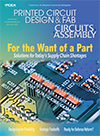Features Articles
 Durability in the heavens can lead to sustainability on Earth.
Durability in the heavens can lead to sustainability on Earth.
We are increasingly reliant on satellite-borne services, as evidenced by the huge increase in launches in the past few years. The United Nations Office for Outer Space Affairs (UNOOSA) has recorded over 5,500 launches between 2020 and 2022 in its Register of Objects Launched into Outer Space. This contrasts with typically 100 to 200 per year from the early 1960s until 2016.
The vast majority of satellites in operation today support communication applications such as Internet services. Of the 6,718 operational satellites at the start of 2023, 4,823 are communication satellites. While their number has increased more than 50% since 2022, there are also over 1,200 Earth observation satellites, up by more than 13%. Others are used for technical development, navigation and positioning, and space observation.
We need the services these space vehicles provide. The Starlink constellation, delivering high-speed Internet services, operates in a low earth orbit at an altitude of about 550km. It can boast much lower latency than typical Internet satellites in higher, geostationary orbits needed to support streaming services and video calls. This enables high-quality services to reach areas where installing ground-based Internet infrastructure is not cost-effective or practicable.
 Over-the-top security controls can do more harm than good.
Over-the-top security controls can do more harm than good.
Is the bureaucracy of security making us all less secure? That is a question I find myself asking increasingly as layer after layer of bureaucracy in the form of forms, protocols and additional steps makes quoting, receiving orders, building product and then shipping and invoicing more cumbersome and time-consuming.
Don't get me wrong: I believe in quality and security, especially in the world we are living in and with the cyber-reliant environment we must utilize to communicate and share data among people and businesses. Increasingly, however, some measures that are intended to increase security instead have the effect of wasting time, adding cost and extending lead times to deliver much-needed product.
 Prepare yourself for unusual circuit patterns.
Prepare yourself for unusual circuit patterns.
There is no free lunch when it comes to populating a printed circuit board. Every part has a cost and a failure rate. One of the first projects of my career was a pulse-Doppler surveillance radar called PSTAR. In typical military jargon, that acronym stands for “Portable Search and Target Acquisition Radar.”
My part was the amplifier module that was subdivided into various blocks for easy field service. One of the sub-blocks was a 20dB coupler. It lived inside its own hermetically sealed aluminum housing. The PCB inside had two traces that ran alongside each other, giving the circuit four ports with feedthroughs to the outside world. SMA connectors and semi-rigid cables wired the various modules together.
My responsibilities included the little housing for the coupler, the overall mechanical packaging and all the semi-rigid cable drawings, as well as the RF amplifier. The control board was the only part designed by an external vendor. Meanwhile, the PCB for the coupler had no more than a single 50Ω termination resistor and the feedthrough connectors. We did not yet have PCB design software at that company, so this was done with AutoCAD.
 Generative AI could transform product design, but raises questions about creative ownership.
Generative AI could transform product design, but raises questions about creative ownership.
The recent ousting and subsequent rehabilitation of OpenAI's CEO added some theater to the debate and buzz around artificial intelligence. AI, it seems, is everywhere and in everything from our smartwatches and phones to automobiles, data centers and factories.
With the explosion in generative AI like OpenAI's ChatGPT, it's also taking on creative roles that we might have assumed would remain the preserve of human intellect. For a while now, it has been possible to generate realistic images of human faces – not copies but unique individuals that never existed except inside a computer. Also, in 2023, the fashion brand Levi's became one of the first companies to suggest it would use AI-generated clothing models. These are expected to improve the shopping experience for customers by helping them assess clothes on likenesses that have a similar body shape and size to their own. Of course, it's also likely to help brands cut marketing and merchandising costs.
Let's set aside the prospects for the first AI catwalk model, or photographer, or bestselling novelist, and consider activities at the border between engineering creativity and design automation.
 Looking within the organization can yield unexpected benefits.
Looking within the organization can yield unexpected benefits.
Benchmarking is an integral part of any continuous improvement strategy. There are typically three types of benchmarking: cross-industry, competitive and internal. Cross-industry benchmarking looks at similar processes in different industries and often delivers the biggest breakthroughs because it helps companies identify processes and systems not widely used in their industries. One example is Southwest Airlines benchmarking NASCAR pit crews’ performance. Competitive benchmarking looks at data from competitors. The challenge is that direct competitors are not likely to share at the level possible with a cross-industry benchmarking exercise, and given the similarity of processes, the best-case improvement is often just being as good as your best competitor.
Internal benchmarking can take two forms. In the first form, processes and systems are evaluated against Lean manufacturing standards to target areas of improvement. In the second form, different facilities of a company are benchmarked to find improvements based on differences in processes and systems.
 A striking lesson in leverage against a larger opponent.
A striking lesson in leverage against a larger opponent.
The worst part is the silence. Experience says silence means they have nothing but bad news to report, and they’re afraid to report it. The technique is notably effective when conveyed (or not because it’s silent) across 10 or more time zones, thereby avoiding real time confrontation. Silence seldom means anything good.
So they say nothing. Employing the time-tested method of patient endurance, they expect by saying nothing that attention will be diverted inevitably, enabling the problem to magically go away. Just like politicians’ common practice, taking a dim view of voters’ average intelligence and grasp of the facts. People have short attention spans. They know that. They count on it.
The problem never goes away. Receivables still age until they’re settled. You have to push. They need to know that you know. Otherwise, they wait it out, and the silence, their friend, prevails. Notch one more for them. And you’re still not paid.
Press Releases
- Altus Group Expands Aftersales Team to Its Largest Size to Date
- Incap Estonia Invests in New Flying robe System to Advance Production Performance
- Critical Manufacturing Partners with Canonical to Expand Cloud-Native Deployment Options for Manufacturers
- Heller Industries Becomes the Latest Partner to Join THE SMT FUTURE EXPERIENCE


